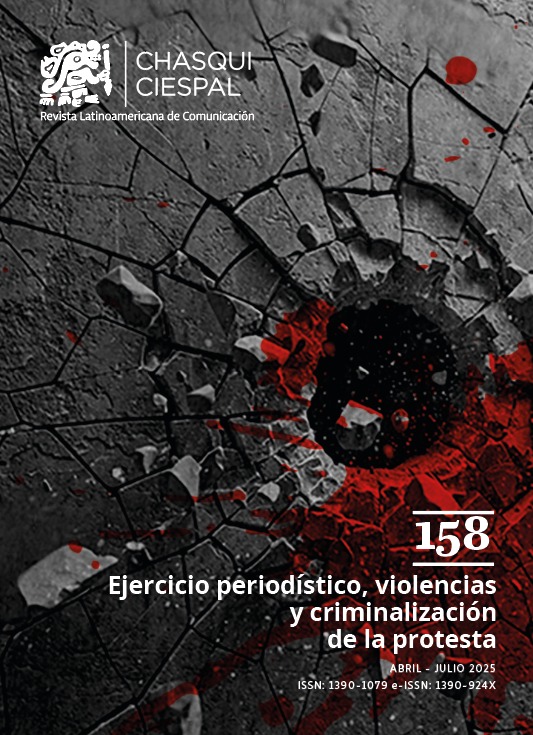La autocensura como forma de violencia
DOI:
https://doi.org/10.16921/chasqui.v1i158.5093Palabras clave:
cultura de la cancelación, wokeísmo, comunicadores, periodismo, autocensura, violenciaResumen
Este artículo explora la relación entre la autocensura y la violencia, analizando sus causas, manifestaciones y consecuencias. Asimismo, examina cómo las estrategias de censura y represión afectan la calidad de la comunicación, incluidos el periodismo y distintas formas artísticas de expresión, al limitar el derecho a la información en deterioro de la democracia y generar un clima de autocensura en los medios de comunicación. La autocensura no sólo opera como una limitación personal, sino como una forma de violencia estructural que, junto a la cancelación cultural y el wokeísmo, condicionan el derecho a la información.Referencias
BOURDIEU, P. (1998). On Television and Journalism. Londres: Pluto Press, 104 pp.
CHEMAMA, R. y B. VANDERMERSCH (2004). Diccionario del Psicoanálisis. Buenos Aires / Madrid: Amorrotu.
CHOMSKY, N. (1997). Media Control: The Spectacular Achievements of Propaganda. Seven Stories Press / The Open Media Pamphlet Series.
CHOMSKY, N.(2001). Propaganda and the Public Mind. Interviews by David Barsamian. London: Pluto Press.
CLARK, M. D. (2020). Drag Them: A brief etymology of so-called Cancel Culture. Communication and the Public, 5(3-4).
DICCIONARIO DE LA LENGUA ESPAÑOLA (2014). Real Academia Española. Madrid: Real Academia Española, 1604 pp.
FUREDI, F. (2021). How Fear Works: Culture of Fear in the 21st Century. Londres / Nueva York: Bloomsbury Continuum, 320 pp.
GILLESPIE, T. (2020). Custodians of the Internet: Platforms, Content Moderation, and the Hidden Decisions That Shape Social Media. New Heaven: Yale University Press, 296 pp.
GRAMSCI, A. (1981). Cuadernos desde la cárcel. 6 tomos. México: Era.
GRAMSCI, A. (1971). Selections from the Prison Notebooks. International Publishers.
GRONDAHL-LARSEN, A, I. FADNES y R. KROVEL. Journalist Safety and Self-Censorship. Londres / Nueva York: Routledge Taylor & Francis Group, 580 pp.
HALLIN, D. C. (1989). The Uncensored War: The Media and Vietnam. Oakland: University of California Press, 285 pp.
HERMAN, E. S. y N. CHOMSKY (1988). Manufacturing Consent: The Political Economy of the Mass Media. Nueva York: Pantheon Books.
JUNGBLUT, M. y A. HOXHA (2017). Conceptualizing journalistic self-censorship in post-conflict societies: A qualitative perspective on the journalistic perception of news production in Serbia, Kosovo and Macedonia. Media, War & Conflict, 19(2), 222-238.
KENNAMER, J. D. (1990). Self-Serving Biases in Perceiving the Opinions of Others. Implications for the Spiral of Silence. Communication Research, 17 (3), junio de 1990, 393-404.
LUKIANOFF, G. y J. HAIDT (2018). The Coddling of the American Mind: How Good Intentions and Bad Ideas Are Setting Up a Generation for Failure. Nueva York: Penguin Press, pp. 352.
MCCHESNEY, R. W. (2008). The Political Economy of Media: Enduring Issues, Emerging Dilemmas. Nueva York: Monthly Review Press, pp. 589.
MCWORTHER, J. (2021, Agosto 17). How Woke Became an Insult. The New York Times.
NOELLE-NEUMANN, E. (1974). The Spiral of Silence: A Theory of Public Opinion. Journal of Communication, 24(2), 43-51.
NG, E. (2020). No Grand Pronouncements Here...: Reflections on Cancel Culture and Digital Media Participation. Television & New Media, 21(6), 621-627.
NOELLE-NEUMANN, E. (1993). The Spiral of Silence: Public Opinion - Our Social Skin. Chicago: University of Chicago Press.
PLUCKROSE, H. y J. LINDSAY (2020). Cynical Theories: How Activist Scholarship Made Everything about Race, Gender, and Identity –and Why This Harms Everybody. Durham: Pitchstone Publishing, 352 pp.
RAMOS ROJAS, D. N. y M. NAVARRO LÓPEZ (2017). Reflexiones acerca de la censura en el periodismo mexicano y su manifestación en la experiencia de los comunicadores locales. Global Media Journal México, 14 (26), 48-69. Tecnológico de Monterrey.
ROUDINESCO, É. y M. PLON (1998). Diccionario de Psicoanálisis. Ediciones Paidós Iberica, 1228 pp.
ROUDINESCO, É. (2017). El inconsciente explicado a mi nieto. Libros del Zorzal, 110 pp.
SCHIMPFÖSSL, E. e I. YABLOKOV (2020). Post-socialist self-censorship: Rusia, Hungary and Latvia. European Journal of Communication, 35(1), 29-45.
SCHIMPFÖSSL, E., I. YABLOKOV, O. ZEVELEVA, T. FEDRIKO y P. BAJOMI-LAZAR (2020). Journalism in Central and Eastern Europe. European Journal of Communication. European Journal of Communication, 35(1), 3-11.
SUNSTEIN, C. R. (2021). Liars: Falsehoods and Free Speech in an Age of Deception. Oxford: Oxford University Press, 192 pp.
TANDOC, E. C. y J. PETERS (2015). One journalist, two roles; what happens when journalist also works as media coordinators? Journalism, 16( 3), 324-340.
TERÁN ELIZONDO, M. I. y M. DEL C. FERNÁNDEZ GALÁN MONTEMAYOR (2017). La Inquisición y la censura de libros en la Nueva España del siglo XVIII. Revista Mexicana De Historia Del Derecho, 36 (julio-diciembre), 181–216.
TRIGLIA, A. (2016). El ello, el yo y el superyó, según Sigmund Freud. Psicología y mente. Recuperado el 28 de febrero de 2028 de: https://psicologiaymente.com/psicologia/ello-yo-superyo-sigmund-freud
Descargas
Publicado
Número
Sección
Licencia
- Los autores/as conservarán plenos derechos de autor sobre su obra y garantizarán a la revista el derecho de primera publicación, el cuál estará simultáneamente sujeto a la Licencia Reconocimiento-SinObraDerivada de Creative Commons (CC BY-ND), que permite a terceros la redistribución, comercial y no comercial, siempre y cuando la obra no se modifique y se transmita en su totalidad, reconociendo su autoría.
- Los autores/as podrán adoptar otros acuerdos de licencia no exclusiva de distribución de la versión de la obra publicada (p. ej.: depositarla en un archivo telemático institucional o publicarla en un volumen monográfico) siempre que se indique la publicación inicial en esta revista.
- Se permite y recomienda a los autores/as difundir su obra a través de Internet.

